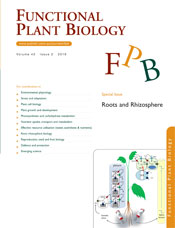
Functional Plant Biology
Volume 43 Number 2 2016
Roots and Rhizosphere
FP15252Root-to-shoot signalling: integration of diverse molecules, pathways and functions
Plant adaptive potential is critically dependent upon efficient communication and co-ordination of resource allocation and signalling between above- and below-ground plant parts by various physical, chemical and molecular signals. This review summarises the current knowledge of these signalling mechanisms, and reveals the hierarchy and discuss integration of these signalling components, to enable optimal plant functioning in a dynamic environment.
FP15249Shoot–root carbon allocation, sugar signalling and their coupling with nitrogen uptake and assimilation
Sugars are not only substrates for diverse metabolic pathways, but also powerful signalling molecules that regulate developmental processes such as flowering. Sucrose produced from mature leaves is translocated through phloem to sink organs. Sugars leaked from phloem may also enter the xylem stream. Here, we assessed advances in understanding how carbon (C) allocation and sugar signalling co-ordinate shoot–root growth. The analyses provided new insights to this topic including the coupling between C and nitrogen (N) uptake and the regulatory proteins and hormonal pathways involved in balancing shoot–root C–N status.
FP15194Root responses of triticale and soybean to soil compaction in the field are reproducible under controlled conditions
Soil compaction is a major environmental threat to arable land that adversely affects root growth and crop productivity. The reproducibility of field results under controlled conditions will be crucial to identify root traits that are suitable for such conditions at high throughput rates. This study showed that root responses to soil compaction in the field were, to a large extent, reproducible under controlled conditions, and that roots were affected by increased mechanical impedance and limited oxygen availability.
FP15162Evolutionary divergences in root system morphology, allocation, and nitrogen uptake in species from high- versus low-fertility soils
The root system of a plant is essential for nutrient acquisition, but our understanding of how root form and function have diverged across soil fertility gradients is limited. Here, we report on several significant differences found in root form and function between species native to environments varying in soil fertility. However, the direction and magnitude of these differences did not always agree with traditional assumptions, indicating that further research is needed to better understand the role of root system traits in adaptation to soil fertility.
FP15211A SDD1-like subtilase is exuded by tobacco roots
Subtilases are proteolytic enzymes with key roles in plant development and signal transduction. SDD1 is a subtilase, which is associated with stomata development in Arabidopsis thaliana. We identified a SDD1-like subtilase in tobacco root exudate that shows high activity with gelatine as substrate. The physiological role of the subtilase remains cryptic but two co-purified proteins provide an informative basis for the identification of in vivo substrates of the subtilase.
FP15245Tracer experiment using 42K+ and 137Cs+ revealed the different transport rates of potassium and caesium within rice roots
Radiocaecium, one of the key pollutants in environment, has been considered to mimic potassium movement within a living organism. Here, the kinetics of radiocaesium at root uptake, passage through root cells, and xylem flow were characterised in comparison with those of potassium. The knowledge about characteristic behaviours of radiocaesium contributes the crop breeding aiming to reduce the radiocaesium contamination.
FP15200Rhizosphere bacteria containing 1-aminocyclopropane-1- carboxylate deaminase increase growth and photosynthesis of pea plants under salt stress by limiting Na+ accumulation
Although ACC-deaminase containing rhizobacteria have previously been shown to improve plant growth under salt stress, this study is the first to investigate ion homeostasis using nutrient flow modelling, and to demonstrate both stomatal and non-stomatal effects of such rhizobacteria on photosynthesis. Variovorax paradoxus 5C-2 may be an eco-friendly and economic means of decreasing deleterious effects of salinity on plant production by improving ion homeostasis and photosynthesis.
FP15200 Abstract | FP15200 Full Text | FP15200PDF (508 KB) Open Access Article
FP15182Wheats developed for high yield on stored soil moisture have deep vigorous root systems
Field selection for wheats with deep, vigorous root systems was performed in India and Australia using soil coring. Variation for deep root traits was observed in 49 Indian wheats grown alongside 41 Australian wheats. Despite the high variability between sites and years several Indian genotypes were identified that ranked consistently for deeper root traits.
FP15244Brachypodium distachyon genotypes vary in resistance to Rhizoctonia solani AG8
Rhizoctonia root rot is a costly disease in wheat and other cereals, and there are no crop varieties available with improved resistance. We found variation in resistance to Rhizoctonia in diverse lines of Brachypodium, a grass that is widely used as a model for the cereals. These lines respond differently during infection and may, with further work, reveal genetic regions in cereals that can be targeted to develop varieties with increased resistance to Rhizoctonia.
FP15303Enhanced root growth of the brb (bald root barley) mutant in drying soil allows similar shoot physiological responses to soil water deficit as wild-type plants
Root hairs drastically increase the surface area of the root system and are believed to be important in nutrient and water uptake. Although a root hairless mutant (brb) and its wild type (WT) maintained similar transpiration rates and leaf elongation in well-watered conditions, in drying soil leaf elongation of brb was diminished during the photoperiod (but not over 24 h), despite having more root biomass than the WT. Thus, root hairs have a limited role in regulating physiological responses to soil drying.
FP15253Salt-stress induced alterations in the root lipidome of two barley genotypes with contrasting responses to salinity
Salinity is an increasing challenge to crop growth in many areas of the world. The root lipids in two barley lines that have different salt tolerance levels were investigated to determine how they change as a result of exposure to saline conditions. Differences in root lipids may provide insight into how plants react to and potentially tolerate high soil salt concentrations.




